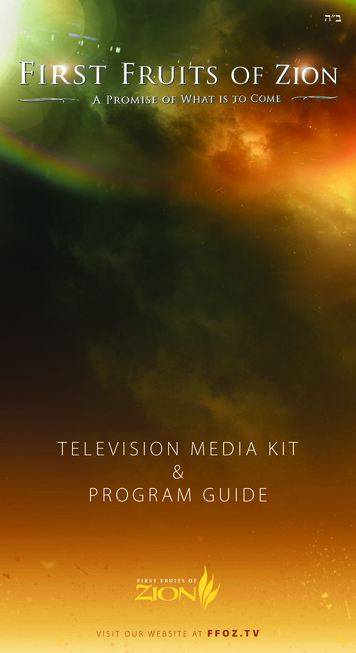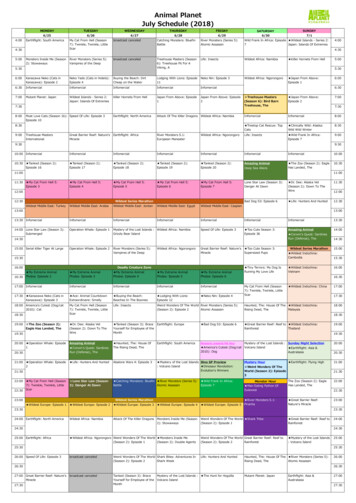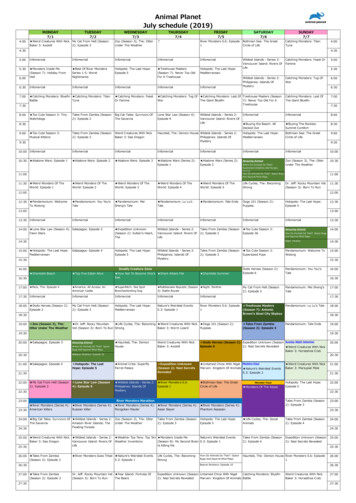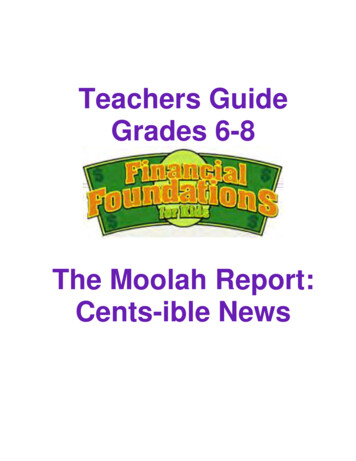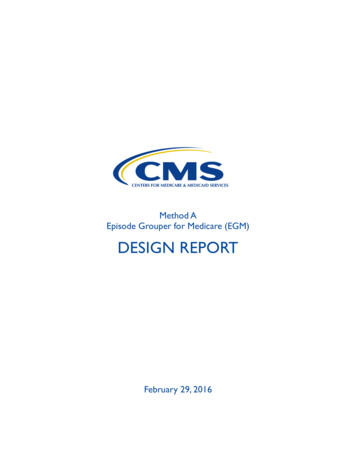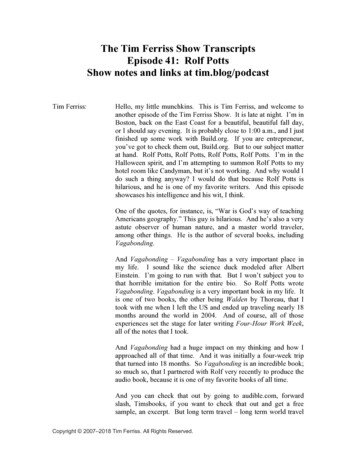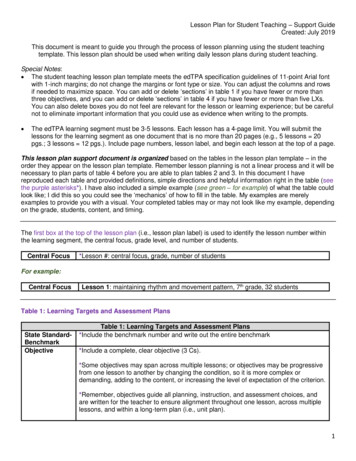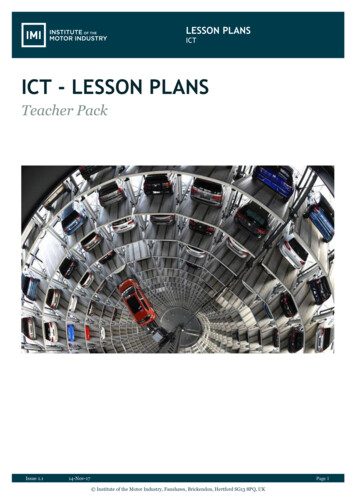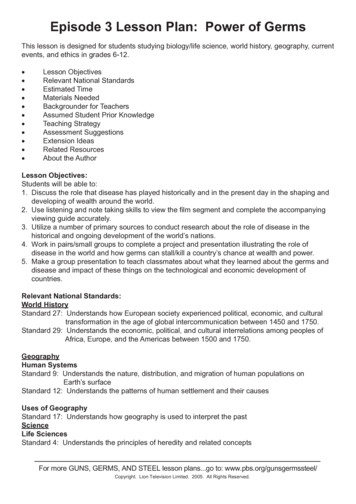
Transcription
Episode 3 Lesson Plan: Power of GermsThis lesson is designed for students studying biology/life science, world history, geography, currentevents, and ethics in grades 6-12. Lesson ObjectivesRelevant National StandardsEstimated TimeMaterials NeededBackgrounder for TeachersAssumed Student Prior KnowledgeTeaching StrategyAssessment SuggestionsExtension IdeasRelated ResourcesAbout the AuthorLesson Objectives:Students will be able to:1. Discuss the role that disease has played historically and in the present day in the shaping anddeveloping of wealth around the world.2. Use listening and note taking skills to view the film segment and complete the accompanyingviewing guide accurately.3. Utilize a number of primary sources to conduct research about the role of disease in thehistorical and ongoing development of the world’s nations.4. Work in pairs/small groups to complete a project and presentation illustrating the role ofdisease in the world and how germs can stall/kill a country’s chance at wealth and power.5. Make a group presentation to teach classmates about what they learned about the germs anddisease and impact of these things on the technological and economic development ofcountries.Relevant National Standards:World HistoryStandard 27: Understands how European society experienced political, economic, and culturaltransformation in the age of global intercommunication between 1450 and 1750.Standard 29: Understands the economic, political, and cultural interrelations among peoples ofAfrica, Europe, and the Americas between 1500 and 1750.GeographyHuman SystemsStandard 9: Understands the nature, distribution, and migration of human populations onEarth’s surfaceStandard 12: Understands the patterns of human settlement and their causesUses of GeographyStandard 17: Understands how geography is used to interpret the pastScienceLife SciencesStandard 4: Understands the principles of heredity and related conceptsFor more GUNS, GERMS, AND STEEL lesson plans.go to: www.pbs.org/gunsgermssteel/Copyright. Lion Television Limited. 2005. All Rights Reserved.
Standard 6: Understands relationships among organisms and their physical environmentStandard 7: Understands biological evolution and the diversity of lifeLanguage ArtsWriting:Standard 4: Gathers and uses information for research purposesReading:Standard 7: Uses reading skills and strategies to understand a variety of information texts.Listening and Speaking:Standard 8: Uses listening and speaking strategies for different purposesViewing:Standard 9: Uses viewing skills and strategies to understand and interpret visual media.Thinking and Reasoning:Standard 1: Understands and applies the basic principles of presenting an argumentStandard 5: Applies basic trouble-shooting and problem-solving techniquesStandard 6: Applies decision-making techniquesWorking With OthersStandard 1: Contributes to the overall effort of the groupStandard 4: Displays effective interpersonal communication skillsEstimated Time:Approximately 2 to 3 90-minute and 4 to 5 45-minute class periodsMaterials Needed: Internet access to allow for viewing of companion website’s “The Story of ” Smallpox andMalaria writing features and conducting research Television/vcr for viewing “Guns, Germs, and Steel: Episode 3” content Viewing Guide handout for each student (printable copy provided with lesson plan) Library/primary resources for conducting research Project Guide for each student (printable copy provided with lesson plan) Assorted art supplies including poster board, construction paper, markers, glue, coloredpencils, and stencils for creating projects and presentations illustrating the power of germs.Backgrounder for Teachers:Teachers will need to look at the role that germs played in the historic conquests of the world aswell as how the spread of these same diseases today is keeping many of the world’s poorestcountries from developing. The economic, social, and technological impact of the spread of germsand disease and how this part of Diamond’s theory remains true even today will be explored in thislesson.Assumed Student Prior KnowledgeFor this lesson, students need to understand Diamond’s theories related to geographic luck andhow this luck allows some countries to growth and conquer while others develop at a much slowerpace. Students will need to understand the words epidemic and endemic.For more GUNS, GERMS, AND STEEL lesson plans.go to: www.pbs.org/gunsgermssteel/Copyright. Lion Television Limited. 2005. All Rights Reserved.
Teaching Strategy:Part 1: The Power of Germs1. Create student interest in the lesson by asking students to answers the following questions ona piece of scratch paper. Most deaths in children under age 5 are due to:A. infectious diseases and malnutritionB. premature birth/birth defectsC. accidents*Answer: A (over 5 million each year die from diseases such as pneumonia anddiarrhea combined with malnutrition—mostly in developing countries) True or False: At least 40% of the deaths in children under age 5 that occur worldwideeach year could be prevented by administering existing vaccines to youngchildren.*Answer: True Of the 5 million children under five who die each year, 2 milliondeaths could be prevented by administering existing vaccines andmost of the rest would be preventable by other means (i.e. goodnutrition, hygiene, clean water, etc.) List what you believe are the 5 most deadly infectious diseases worldwide.*Answer: Acute Lower Respiratory Infections/Pneumonia (3.7 million),Tuberculosis (2.9 million), Diarrhea (2.5 million), HIV/AIDS (2.3 million),and Malaria (1.5-2.7 million)*Source: World Health Organization “50 Facts: Global Health Situation and Trends1955-2025”2. Once students have answered each question, facilitate a class discussion and provide studentswith the correct answers to each question. In the discussion, pose questions such as: Were you surprised by the answers to any of the questions? If so, which ones, and why? As a person living in the U.S., would you expect to suffer from the infectious diseases thatare the top killers worldwide? Why? In an age where so much medical technology is available, particularly in the formof medications and vaccines, why do you think so many people are still dying frompreventable diseases? How does it make you feel when you think about people in developing countries dying fromthese types of diseases at alarmingly high rates? Who should be responsible for helping to eradicate these diseases? Why?3. Focus student attention on the content of “Guns, Germs, and Steel” by reminding studentsabout the question that started Jared Diamond’s research: Why do some societies have somuch while others have so little? Remind students of Diamond’s theory that geographydetermines which societies flourish and grow and which are conquered and lag behind in thedevelopment of technology, power, and wealth. At the heart of this theory is the idea thatguns, germs, and steel ultimately gave some groups advantages over others. Direct studentsto the “The World” feature at http://www.pbs.org/gunsgermssteel/world/index.html to review anddocument the statistics about disease and poverty rates in the countries described when eachportion of the map is engaged.4. Distribute the Viewing Guide to students. Take time to read over the questions beforeviewing “Guns, Germs, and Steel: Episode 3”. If there are time limits on the amount ofFor more GUNS, GERMS, AND STEEL lesson plans.go to: www.pbs.org/gunsgermssteel/Copyright. Lion Television Limited. 2005. All Rights Reserved.
viewing that can take place, excerpt the episode and view the following segments: Beginning of episode to 6:50 (explains European settlement in Africa) 8:26 to 10:01 (introduction of European diseases to Africa) 33:50 to 40:53 (describes the effects of diseases native to the tropics on European settlers) 42:39 to 48:01 (describes how malaria, to which many Africans once had immunity, is nowan endemic and the number one health problem in Africa because of the physiological andcultural changes the country has experienced over the last 100 years) 50:37 t o 52:32 (discusses how other tropical countries have become rich and powerful byaddressing the problems that geography and germs caused and eradicating them in orderto gain wealth and power in the world)5. Once students have viewed the film, have them learn more about Smallpox and Malariaand how these diseases effected the development of world powers. Have students accessthis information at ox.html and a.html and answer questions 11-12 on theViewing Guide.6. After students have completed the Viewing Guide, take time to discuss each question,referring back to the film or the companion website materials as needed. Encourage studentsto add to their answers so they can use this information as they complete the projects in Part 2of the lesson.Part 2: Combating Germs Worldwide1. Students have learned about and discussed the role of germs in the development of nationsthroughout the world. Using what they have learned from viewing the film, reading the contentfrom the companion website, and class discussions, have students work in pairs or smallgroups to create a project related to what they have learned about the impact germs haveon the development of a society/country. Using the Project Guide, direct students as theycomplete one of the projects described and prepare to present it to the class.2. Provide students with classroom time to conduct research and create their projects. Monitorstudents frequently to ensure they are completing the project according to the establishedguidelines.3. When projects are completed, provide each pair/group with class time to present what theyhave learned and developed to the rest of the class.4 . When all projects have been completed, provide an area in the classroom for students todisplay their work.Assessment Suggestions:1. Students could receive participation scores/grades for answering and discussing the infectiousdisease questions, participating in class discussion and debate, and completion of groupresearch for project presentation.2. Students could receive completion or accuracy grades for their work on the Viewing Guides.3. Students could complete peer evaluations and self evaluation or be graded using a scoringguide for completion of the project and the accompanying presentation.Extension Ideas:1. Have students write letters to the editor of to their congressional representatives stating theiropinions about what should be done in the U.S. to help developing countries fight preventableFor more GUNS, GERMS, AND STEEL lesson plans.go to: www.pbs.org/gunsgermssteel/Copyright. Lion Television Limited. 2005. All Rights Reserved.
diseases and save people, many of them children, from dying from diseases that have beeneradicated or are easily preventable in technologically advanced and wealthier countries.2. Conduct a classroom debate about the U.S. and groups such as the World Health Organizationshould be doing to increase awareness about diseases such as HIV/AIDS and tuberculosis andto fight the spread of these diseases on a global level.Related Resources:“Guns, Germs, and Steel” website sections entitled:“The World” feature available at http://www.pbs.org/gunsgermssteel/world/index.html illustrates thedisease and poverty rates in many different regions of the worldVariables (“The story of ” Smallpox and Malaria features content about each of the diseasesand their historical significance and can be found htmlWorld Health Organizationhttp://www.who.int/whr/1998/media centre/50facts/en/provides detailed information about global health trends from 1955 and projected into 2025.National Institute of Allergy and Infectious htmprovides a step-by-step look at how the body’s immune system works to fight disease and produceantibodiesNational Library of re.htmprovides information about the possible agents and effects of biological warfareAbout the AuthorLisa Prososki is an independent educational consultant who taught middle school and high schoolsocial studies, English, reading, and technology courses for twelve years. Prososki has workedwith PBS TeacherSource and has authored many lesson plans for various PBS programs overthe past five years. In addition to conducting workshops for teachers at various state and nationalconventions, Prososki has also worked as an editor and authored one book.For more GUNS, GERMS, AND STEEL lesson plans.go to: www.pbs.org/gunsgermssteel/Copyright. Lion Television Limited. 2005. All Rights Reserved.
Television/vcr for viewing "Guns, Germs, and Steel: Episode 3" content Viewing Guide handout for each student (printable copy provided with lesson plan) Library/primary resources for conducting research

